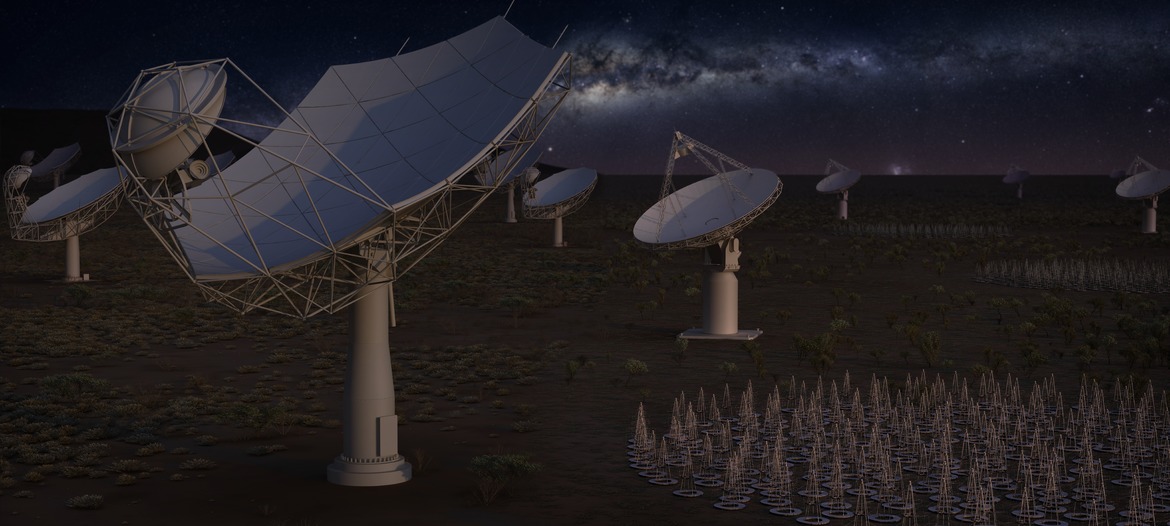
The largest science facility on Earth just hit a big milestone on the road from concept to reality.
Representatives of countries involved in the Square Kilometre Array (SKA) project signed a treaty in Rome Tuesday (March 12), officially establishing the organization that will oversee and operate the gigantic radio-telescope network.
"Rome wasn't built in a day. Likewise, designing, building and operating the world's biggest telescope takes decades of efforts, expertise, innovation, perseverance and global collaboration," Catherine Cesarsky, chair of the SKA board of directors, said in a statement Tuesday. "Today, we've laid the foundations that will enable us to make the SKA a reality."
Related: 10 Biggest Telescopes on Earth: How They Measure Up
The SKA will consist of hundreds of radio dishes and thousands of smaller antennas installed across South Africa and Australia. The total collecting area of the dishes will be about 1 square kilometer, or 0.4 square miles — hence the name.
When this network gets up and running — a milestone currently targeted for the mid-2020s — it will be the most sensitive and powerful radio telescope on Earth by a large margin, project representatives have said. Astronomers will use SKA for a variety of purposes, from studying gravitational waves to mapping hundreds of millions of galaxies to hunting for signs of intelligent alien life.
"Like Galileo's telescope in its time, the SKA will revolutionize how we understand the world around us and our place in it," Philip Diamond, director-general of the SKA Organization, the body leading the array's design, said in the same statement. "Today's historic signature shows a global commitment behind this vision and opens up the door to generations of groundbreaking discoveries."
Get the Space.com Newsletter
Breaking space news, the latest updates on rocket launches, skywatching events and more!

The new treaty sets up the Square Kilometer Array Observatory (SKAO), which is tasked with building and operating the huge telescope network. Representatives of seven countries — Australia, China, Italy, The Netherlands, Portugal, South Africa and the United Kingdom — signed the treaty Tuesday, SKA project representatives said.
Those seven nations, along with India and Sweden, which are expected to sign the treaty soon, are the SKAO's founding members. Project headquarters are in the U.K.
The first SKA construction contracts are expected to be awarded late next year. These contracts are expected to be worth a total of nearly 700 million euros ($792 million at current exchange rates), project representatives said.
- Happy Birthday, Arecibo! Iconic Radio Telescope Survives Hurricane, Funding Challenges
- The Arecibo Observatory: Puerto Rico's Giant Radio Telescope in Photos
- China Plans to Build the World's Largest Steerable Radio Telescope
Mike Wall's book about the search for alien life, "Out There" (Grand Central Publishing, 2018; illustrated by Karl Tate), is out now. Follow him on Twitter @michaeldwall. Follow us on Twitter @Spacedotcom or Facebook.
Join our Space Forums to keep talking space on the latest missions, night sky and more! And if you have a news tip, correction or comment, let us know at: community@space.com.

Michael Wall is a Senior Space Writer with Space.com and joined the team in 2010. He primarily covers exoplanets, spaceflight and military space, but has been known to dabble in the space art beat. His book about the search for alien life, "Out There," was published on Nov. 13, 2018. Before becoming a science writer, Michael worked as a herpetologist and wildlife biologist. He has a Ph.D. in evolutionary biology from the University of Sydney, Australia, a bachelor's degree from the University of Arizona, and a graduate certificate in science writing from the University of California, Santa Cruz. To find out what his latest project is, you can follow Michael on Twitter.









